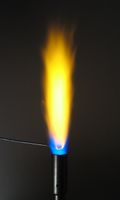



A pyrotechnic colorant is a chemical compound which causes a flame to burn with a particular colour. These are used to create the colours in pyrotechnic compositions like fireworks and coloured fires. The colour-producing species are usually created from other chemicals during the reaction. Metal salts are commonly used; elemental metals are used rarely (e.g. copper for blue flames).
Contents
The colour of the flame is dependent on the metal cation; the anion of the salt has very little direct influence. The anions however influence the flame temperature, both by increasing it (e.g. nitrates, chlorates) and decreasing it (e.g. carbonates, oxalates), indirectly influencing the flame brightness and brilliancy. For temperature-decreasing additives, the limit of colorant may be about 10–20 wt.% of the composition. [1]
Some common examples are:
| Colour | Compound name | Chemical formula | Notes |
|---|---|---|---|
| Red | Strontium nitrate | Sr(NO3)2 | Common. Used with chlorine donors. Excellent red, especially with metal fuels. Used in many compositions including road flares. |
| Red | Strontium carbonate | SrCO3 | Common. Produces good red. Slows burning of compositions, decomposes yielding carbon dioxide. Fire retardant in gunpowders. Inexpensive, non-hygroscopic, neutralizes acids. Superior over strontium oxalate in absence of magnesium. |
| Red | Strontium oxalate | SrC2O4 | Decomposes yielding carbon dioxide and carbon monoxide. In presence of magnesium fuel, carbon monoxide reduces particles of magnesium oxide, yielding gaseous magnesium and eliminating the black-body radiation of the MgO particles, resulting in clearer colour. |
| Red | Strontium sulfate | SrSO4 | Common. High-temperature oxidizer. Used in strobe mixtures and some metal-based red compositions. |
| Red | Strontium chloride | SrCl2 | Common. Produces bright red flame. |
| Orange | Calcium carbonate | CaCO3 | Produces orange flame. Yields carbon dioxide on decomposition. Often used in toy fireworks as a substitute for strontium. |
| Orange | Calcium chloride | CaCl2 | |
| Orange | Calcium sulfate | CaSO4 | High-temperature oxidizer. Excellent orange source in strobe compositions. |
| Orange | Hydrated calcium sulfate | CaSO4(H2O)x* | The * indicates that the compound will burn orange where x=0,2,3,5. |
| Gold/Yellow | Charcoal powder | ||
| Yellow | Sodium bicarbonate | NaHCO3 | Compatible with potassium chlorate. Less burning rate decrease than sodium carbonate. Incompatible with magnesium and aluminium, reacts evolving hydrogen gas. |
| Yellow | Sodium carbonate | Na2CO3 | Hygroscopic. Significantly decreases burning rate, decomposes evolving carbon dioxide. Strongly alkaline. Very effective colorant, can be used in small amounts. Corrodes magnesium and aluminium, incompatible with them. |
| Yellow | Sodium chloride | NaCl | Loses hygroscopicity on heating. Corrodes metals. |
| Yellow | Sodium oxalate | Na2C2O4 | Non-hygroscopic. Slightly reacts with magnesium, no reaction with aluminium. |
| Yellow | Sodium nitrate | NaNO3 | Also acts as oxidizer. Bright flame, used for illumination. |
| Yellow | Cryolite | Na3AlF6 | One of the few sodium salts that is nonhygroscopic and insoluble in water. |
| Green | Barium chloride | BaCl2 | |
| Green | Barium chlorate | Ba(ClO3)2 | Classic exhibition green with shellac fuel. Sensitive to shock and friction. Oxidizer. |
| Green | Barium carbonate | BaCO3 | A pretty colour when ammonium perchlorate is used as oxidizer. |
| Green | Barium nitrate | Ba(NO3)2 | Not too strong effect. With chlorine donors yields green colour, without chlorine burns white. In green compositions usually used with perchlorates. |
| Green | Barium oxalate | BaC2O4 | |
| Blue | Copper(I) chloride | CuCl | The richest blue flame. Almost insoluble in water. |
| Blue | Copper(I) oxide | Cu2O | Lowest cost blue colorant. |
| Blue | Copper(II) oxide | CuO | Used with chlorine donors. Excellent in composite stars. |
| Blue | Basic copper carbonate | CuCO3·Cu(OH)2, 2 CuCO3·Cu(OH)2 | Occurs naturally as malachite and azurite. Good with ammonium perchlorate and for high-temperature flames with presence of hydrogen chloride. Not easily airborne, less poisonous than Paris Green. |
| Blue | Copper oxychloride | 3CuO·CuCl2 | Good blue colorant with suitable chlorine donor. |
| Blue | Paris Green | Cu(CH3COO)2.3Cu(AsO2)2 | Copper acetoarsenite, Emerald Green. Toxic. With potassium perchlorate produces the best blue colours. Non-hygroscopic. Fine powder readily becomes airborne; toxic inhalation hazard. |
| Blue | Copper arsenite | CuHAsO3 | Almost non-hygroscopic. Almost as good colorant as copper acetoarsenite. Toxic. Can be used with chlorate oxidizers. |
| Blue | Copper sulfate | CuSO4·5 H2O | Can be used with nitrates and perchlorates. Acidic, incompatible with chlorates. With red phosphorus in presence of moisture liberates heat, may spontaneously ignite. Less expensive than copper acetoarsenite. Anhydrous copper sulfate is hygroscopic, can be used as a desiccant. With ammonium perchlorate produces an almost as pretty a blue colour as achievable with copper acetoarsenite. |
| Blue | Copper metal | Cu | Rarely used, other compounds are easier to work with. Yields pretty blue colour in ammonium perchlorate based compositions; but reacts with ammonium perchlorate and liberates ammonia in presence of moisture. The composition must be kept dry. |
| Purple | Combination of red and blue compounds | Sr+Cu | |
| Purple | Rubidium compounds | Rb | rarely used |
| Silver/White | Aluminium powder | Al | |
| Silver/White | Magnesium powder | Mg | |
| Silver/White | Titanium powder | Ti | |
| Silver/White | Antimony (III) sulfide | Sb2S3 | |
| Infrared | Caesium nitrate | CsNO3 | two powerful spectral lines at 852.113 nm and 894.347 nm |
| Infrared | Rubidium nitrate | RbNO3 |